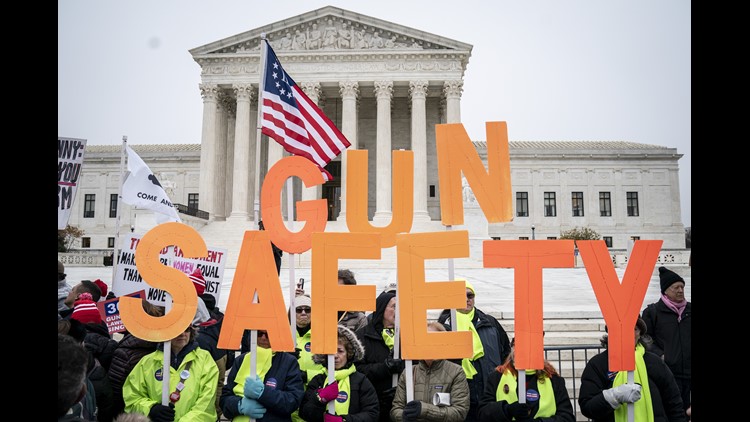(CNN) — After nearly a decade of silence, a divided Supreme Court grappled Monday for over an hour with a case testing the scope of an individual’s right to keep and bear arms in a dispute concerning a New York City gun regulation.
The case is being carefully watched by supporters of gun rights who want the newly solidified conservative majority of the court to broaden those rights. But looming over the case is the fact that after the Supreme Court agreed to hear the issue, the law at issue was changed.
The liberal justices, led by Ruth Bader Ginsburg, all suggested that the case should be dismissed as a result.
“What’s left of this case?” Ginsburg asked.
“You are asking us to take a case where the other side has thrown in the towel,” added Justice Sonia Sotomayor.
But critically, neither Chief Justice John Roberts nor Justice Brett Kavanaugh revealed whether they thought the case should be considered moot. In fact, Kavanaugh asked no questions at all.
Conservative Justices Neil Gorsuch and Samuel Alito clearly thought the controversy is still alive, with Alito, more than any other justice, suggesting that even the amended law still violates the Second Amendment.
Gorsuch said at one point that even under the new law, a licensed handgun owner would not be able to make a stop along the way to a nearby shooting range. He suggested the case was not moot, but instead, “a live controversy” that the court should decide. And Alito pushed back on the notion that the challengers had gotten all that they wanted. He also went further than any other justice discussing why he thought Second Amendment rights were being violated.
If the conservatives agree to get to the merits of the case, it is possible that they would expand gun rights, but after an hour of arguments it was unclear if there were the necessary votes to get there.
The New York City gun law regulates where licensed handgun owners can take a locked and unloaded handgun. When the Supreme Court agreed to take up the case, the law blocked licensed individuals from removing a handgun from the address listed on the license except to travel to nearby authorized small arms ranges or shooting clubs.
Since then, the city allowed licensed owners to take handguns to other locations, including second homes or shooting ranges outside city limits. In addition, the State of New York amended its handgun licensing statute to require localities to allow licensed gun owners to engage in such transport.
Biggest case in a decade
In 2008, the late Justice Antonin Scalia’s wrote a landmark opinion in DC v. Heller holding for the first time that an individual has a right to keep a handgun at home for self-protection. Two years later, the court issued a follow up opinion.
Since then, the court has largely avoided taking up a follow on case. Supporters of gun rights believe lower courts have been thumbing their noses at Heller and are eager for a newly solidified 5-4 conservative majority to take up the issue again.
Indeed, Justice Clarence Thomas has been the most vocal member of the court urging his colleagues to step in. In a 2018 dissent joined by Gorsuch, Thomas said lower courts were treating the Second Amendment as a “disfavored right.”
Some court watchers believe that the court stayed away from the issue because Justice Anthony Kennedy was not eager to take up a new case, instead preferring to let the issue percolate in the lower courts. They believe that his replacement, Kavanaugh, may be further to the right on the issue, although his position was unclear on Monday.
Changing the law
Critics of the law say that the only reason New York amended the law was because supporters of gun regulations feared that the Supreme Court’s new conservative majority might use the idiosyncratic law to render a broad decision cutting back on gun restrictions.
The New York State Rifle & Pistol Association and individual plaintiffs challenged the law arguing that it was too restrictive and that a New Yorker could not transport his handgun to his “second home for the core constitutional purpose of self-defense or to an upstate county to participate in a shooting competition, or even across the bridge to a neighboring city for target practice.”
Paul Clement, representing the New York State Rifle & Pistol Association and other petitioners, called the attempts to change the law “the product of an acknowledged City-orchestrated effort to frustrate this Court’s review.”
He said that the city’s actions don’t fix problems with the law.
“The revised regulations,” Clement argued in court papers, “demand continuous and uninterrupted transport (forbidding a stop at a gas station or a coffee shop en route), require written permission before a handgun can be taken to a gunsmith, and preclude transport to a summer rental house.”
Clement said there was nothing to stop the city, or another jurisdiction, from implementing a similar law.
“The City’s begrudging revisions to its restrictive transport ban reflect the City’s unwavering view that the ability to transport a licensed handgun is a matter of government-conferred privilege, rather than a constitutional right,” he wrote.



